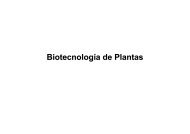Pectin esterase gene family in strawberry fruit - Journal of ...
Pectin esterase gene family in strawberry fruit - Journal of ...
Pectin esterase gene family in strawberry fruit - Journal of ...
Create successful ePaper yourself
Turn your PDF publications into a flip-book with our unique Google optimized e-Paper software.
FaPE1 and ethylene <strong>in</strong> <strong>strawberry</strong> <strong>fruit</strong> senescence 915<br />
Fig. 6. Northern blot analysis <strong>of</strong> FaPE1 expression dur<strong>in</strong>g senescence<br />
<strong>of</strong> <strong>strawberry</strong> <strong>fruit</strong> whilst either detached or attached to their parent<br />
plant. Attached <strong>fruit</strong> were allowed to senesce until overripe (OR),<br />
whilst detached <strong>fruit</strong> were allowed to ripen for 48 h.<br />
Fig. 5. (A) Schematic representation <strong>of</strong> the 1.6 Kb FaPE1 promoter<br />
region. The putative TATA-box and the predicted ethylene responsive<br />
elements (EREs) have been highlighted. Number<strong>in</strong>g is relative to the<br />
®rst nucleotide <strong>of</strong> the translation <strong>in</strong>itiation codon. (B) Northern blot<br />
analysis <strong>of</strong> FaPE1 expression. Total RNA (15 mg) was extracted from<br />
ripe <strong>strawberry</strong> <strong>fruit</strong>s that were treated with 50 ml l ±1 ethylene for 24<br />
h. Control <strong>fruit</strong>s were kept <strong>in</strong> air. (C) FaPE1 expression <strong>in</strong> ripe<br />
<strong>strawberry</strong> <strong>fruit</strong>s that were treated for 24 h with 600 ml l ±1 <strong>of</strong> 1-MCP.<br />
Control <strong>fruit</strong>s were the same as <strong>in</strong> (B).<br />
showed a decrease <strong>in</strong> FaPE1 mRNA accumulation compared<br />
with the control air-treated <strong>fruit</strong>s (Fig. 5B). F7 <strong>fruit</strong>s<br />
were also treated with the <strong>in</strong>hibitor <strong>of</strong> ethylene action 1-<br />
methyl cyclopropene (1-MCP). After 24 h <strong>of</strong> treatment,<br />
FaPE1 mRNA levels were higher <strong>in</strong> 1-MCP treated <strong>fruit</strong>s<br />
(Fig. 5C), thus strongly support<strong>in</strong>g the fact <strong>of</strong> a negative<br />
regulation <strong>of</strong> FaPE1 expression exerted by the hormone<br />
ethylene.<br />
FaPE1 expression <strong>in</strong> senesc<strong>in</strong>g <strong>strawberry</strong> <strong>fruit</strong>s<br />
FaPE1 expression was also analysed <strong>in</strong> overripe <strong>fruit</strong>s.<br />
Firstly, several <strong>fruit</strong>s were harvested at the ripe stage (F7)<br />
and left to overripen on the shelf for 24 or 48 h at 21 °C. A<br />
second set <strong>of</strong> <strong>fruit</strong>s were ma<strong>in</strong>ta<strong>in</strong>ed on the v<strong>in</strong>e and<br />
harvested after 48 h and several days later when <strong>fruit</strong>s<br />
showed clear symptoms <strong>of</strong> senescence i.e., a semi-melted<br />
texture. Dur<strong>in</strong>g senescence, <strong>fruit</strong>s that were ma<strong>in</strong>ta<strong>in</strong>ed on<br />
the plant showed a progressive reduction <strong>in</strong> FaPE1<br />
transcripts, be<strong>in</strong>g undetectable at the overripe stage<br />
(Fig. 6). Similarly, <strong>in</strong> detached <strong>fruit</strong>s ma<strong>in</strong>ta<strong>in</strong>ed at room<br />
temperature FaPE1 mRNA levels also decreased.<br />
However, the k<strong>in</strong>etics <strong>of</strong> the process was faster and<br />
FaPE1 transcripts were hardly detected after 24 h (Fig. 6).<br />
Discussion<br />
Changes <strong>in</strong> the pect<strong>in</strong> matrix are regarded as an important<br />
factor that affects cell wall structure dur<strong>in</strong>g ripen<strong>in</strong>g and<br />
senescence. In this context, PE activity is a key control<br />
po<strong>in</strong>t for both the assembly and disassembly <strong>of</strong> pect<strong>in</strong><br />
networks. Homogalacturonic acid (HGA) is an abundant<br />
and widespread component <strong>of</strong> the polysaccharide complex,<br />
commonly termed `pect<strong>in</strong>', that appears to be<br />
synthesized <strong>in</strong> the Golgi apparatus <strong>in</strong> a highly methylesteri®ed<br />
state (Doong et al., 1995). Subsequent to its<br />
<strong>in</strong>corporation <strong>in</strong>to the extracellular matrix, HGA <strong>of</strong>ten<br />
become enzymatically de-esteri®ed by the action <strong>of</strong> the<br />
enzyme PE. De-esteri®cation <strong>of</strong> HGA <strong>in</strong>creases the<br />
negative charge density <strong>in</strong> the cell wall microenvironment.<br />
Therefore HGA can be cross-l<strong>in</strong>ked by divalent cations,<br />
such as calcium, result<strong>in</strong>g <strong>in</strong> supramolecular assemblies<br />
and gels. The formation <strong>of</strong> these calcium-mediated pect<strong>in</strong><br />
gels signi®cantly affects the mechanical properties <strong>of</strong> the<br />
cell wall and adds rigidity to the wall (Jarvis, 1984; Willats<br />
et al., 2001). However, the degree and pattern <strong>of</strong> methyl<br />
esteri®cation is also important <strong>in</strong> regulat<strong>in</strong>g the cleavage <strong>of</strong><br />
HGA by pect<strong>in</strong>olytic enzymes, such as polygalacturonase<br />
and pectate lyase, and may <strong>in</strong>¯uence the activities <strong>of</strong> other<br />
wall-associated enzymes by alter<strong>in</strong>g the pH <strong>of</strong> the local<br />
environment (Pressey and Avants, 1982; Almeida and<br />
Huber, 1999).<br />
In this paper, the existence <strong>of</strong> four <strong>strawberry</strong> PE-related<br />
<strong>gene</strong>s is reported, three <strong>of</strong> them expressed dur<strong>in</strong>g <strong>fruit</strong><br />
development at a level that could be detected by northern<br />
blot hybridization. The occurrence <strong>of</strong> multiple is<strong>of</strong>orms <strong>of</strong><br />
PE <strong>in</strong> <strong>strawberry</strong> <strong>fruit</strong> was expected as several PE is<strong>of</strong>orms<br />
have previously been described <strong>in</strong> different <strong>fruit</strong>s such as<br />
tomato, peach, and banana (Hall et al., 1994; Glover and<br />
Brady, 1994; Nguyen et al., 2002b), and also <strong>in</strong> a<br />
<strong>strawberry</strong> <strong>fruit</strong> EST collection (Aharoni and O'Connell,<br />
2002). It is possible that the different <strong>gene</strong>s may encode<br />
prote<strong>in</strong>s with slightly different functions <strong>in</strong> the cell wall or<br />
temporally associated with a particular cell type, tissue or<br />
organ through plant development. Each FaPE <strong>gene</strong><br />
showed a unique expression pro®le and it was possible to<br />
classify them <strong>in</strong>to functionally dist<strong>in</strong>ct groups as determ<strong>in</strong>ed<br />
for other PE <strong>gene</strong> families (Micheli et al., 1998;<br />
Gaffe et al., 1994). The ®rst FaPE group comprises <strong>gene</strong>s<br />
show<strong>in</strong>g an organ-speci®c expression, at least at a level<br />
detectable by northern blot; this <strong>in</strong>cludes FaPE1 <strong>in</strong><br />
ripen<strong>in</strong>g <strong>fruit</strong> and FaPE2 <strong>in</strong> leaves. Ripen<strong>in</strong>g stages<br />
where FaPE1 expression were detected co<strong>in</strong>cided with the<br />
PE activity pro®le described by Barnes and Patchett





